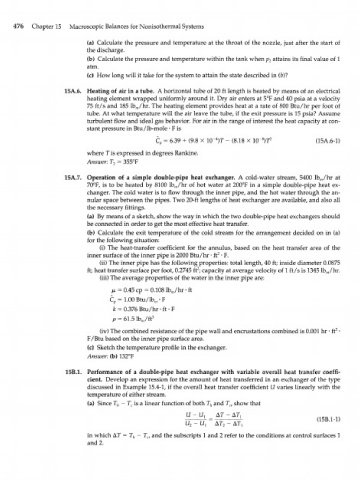Page 496 - Bird R.B. Transport phenomena
P. 496
476 Chapter 15 Macroscopic Balances for Nonisothermal Systems
(a) Calculate the pressure and temperature at the throat of the nozzle, just after the start of
the discharge.
(b) Calculate the pressure and temperature within the tank when p attains its final value of 1
2
atm.
(c) How long will it take for the system to attain the state described in (b)l
15A.6. Heating of air in a tube. A horizontal tube of 20 ft length is heated by means of an electrical
heating element wrapped uniformly around it. Dry air enters at 5°F and 40 psia at a velocity
75 ft/s and 185 lb /hr. The heating element provides heat at a rate of 800 Btu/hr per foot of
m
tube. At what temperature will the air leave the tube, if the exit pressure is 15 psia? Assume
turbulent flow and ideal gas behavior. For air in the range of interest the heat capacity at con-
stant pressure in Btu/lb-mole • F is
8
4
C p = 6.39 + (9.8 X 10" )T - (8.18 X 10" )T 2 (15A.6-1)
where Г is expressed in degrees Rankine.
Answer: T 2 = 355°F
15A.7. Operation of a simple double-pipe heat exchanger. A cold-water stream, 5400 lb /hr at
m
70°F, is to be heated by 8100 lb /hr of hot water at 200°F in a simple double-pipe heat ex-
w
changer. The cold water is to flow through the inner pipe, and the hot water through the an-
nular space between the pipes. Two 20-ft lengths of heat exchanger are available, and also all
the necessary fittings.
(a) By means of a sketch, show the way in which the two double-pipe heat exchangers should
be connected in order to get the most effective heat transfer.
(b) Calculate the exit temperature of the cold stream for the arrangement decided on in (a)
for the following situation:
(i) The heat-transfer coefficient for the annulus, based on the heat transfer area of the
inner surface of the inner pipe is 2000 Btu/hr • ft 2 • F.
(ii) The inner pipe has the following properties: total length, 40 ft; inside diameter 0.0875
ft; heat transfer surface per foot, 0.2745 ft ; capacity at average velocity of 1 ft/s is 1345 lb /hr.
2
m
(iii) The average properties of the water in the inner pipe are:
ix = 0.45 cp = 0.108 lb /hr • ft
m
C,= 1.00Btu/lb -F
n;
к = 0.376 Btu/hr • ft • F
p = 61.51b /ft 3
w
2
(iv) The combined resistance of the pipe wall and encrustations combined is 0.001 hr • ft •
F/Btu based on the inner pipe surface area.
(c) Sketch the temperature profile in the exchanger.
Answer: (b) 132°F
15B.1. Performance of a double-pipe heat exchanger with variable overall heat transfer coeffi-
cient. Develop an expression for the amount of heat transferred in an exchanger of the type
discussed in Example 15.4-1, if the overall heat transfer coefficient U varies linearly with the
temperature of either stream.
(a) Since T - T is a linear function of both T and T , show that
c
r
h
h
U - и АТ - AT!
2 л 2
in which AT = T - T , and the subscripts 1 and 2 refer to the conditions at control surfaces 1
h
c
and 2.

